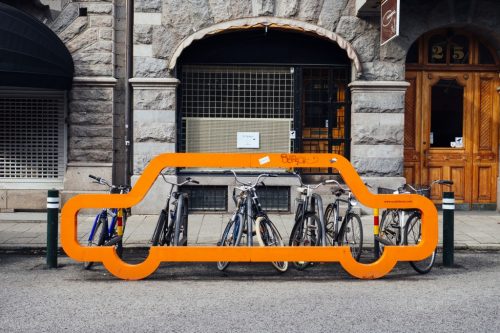Electric bicycles are no longer a passing trend or an obscene hobby of teenagers, and they fill the roads (and sidewalks) of cities. Are they good for the environment? Depends on what vehicles they are replacing and how they are used
Assaf Ben Naria, Angle - Science and Environment News Agency
Light rail, fast routes for public transportation, new railroads, projects for collaborative travel, autonomous vehicles and even flying cars - all of these guarantee us that we will reach our destination in a faster, smoother and more environmentally friendly way. The target date of most programs ranges from 2020 to an unknown date; In any case, for the hundreds of thousands of passengers who are stuck in traffic on a daily basis and for the 1,250 early deaths in Israel as a result of air pollution originating from transportation (according to OECD data) and about 350 deaths in traffic accidents - none of this really matters.
The transportation problems in Israel and the high costs of maintaining and driving a private vehicle force many to choose alternative means of transportation, the most prominent of which in recent years are electric bicycles. Along with the harsh criticism of irresponsible cyclists who cut lanes wildly and drive on sidewalks at speed, it is clear that this is an environmentally friendly means of transportation that can help reduce the load on the roads and reduce the air pollution that results from driving vehicles with an internal combustion engine.
A series of studies conducted in recent years, following the increase in the use of electric bicycles in cities around the world, tried to check how green the electric bicycles are, and what is the environmental price we still pay for riding them. The results are in front of you.

A hundred times more efficient than a private car
With regard to air pollution and the emission of greenhouse gases into the atmosphere, the studies are unanimous: in relation to the car, the scooter and also to public transportation, riding an electric bicycle is the form of transportation that has the least negative impact on the environment.
A comparative study conducted in the USA, for example, weighed the emissions of greenhouse gases in the various means of transportation throughout their complete life cycle, that is - from the production process to the recycling of the product at the end of its life. Among the various means of transportation, which included flying in a Boeing 737 plane, traveling by bus, driving a private car, walking and pedaling regular and electric bicycles - the last three received the best marks.
Even in terms of energy consumption, the electric bikes came out on top. In Lisbon, researchers compared the energy consumption and travel times of a bus, a conventional private car, an electric vehicle and an electric bicycle for the same 8.5 km urban road section, which included several ups and downs. The energy consumption included two components: "from the mine to the tank" (Well to tank), which represents the energy involved in the production and production of the fuels that drive the vehicles, whether they are used as an electric power station or to fill the fuel tank; and "Tank to wheel", which includes only the movement phase, i.e. the energy consumed during the trip. Both components were calculated per kilometer, and depending on the distance the vehicle will travel throughout its life.
The researchers found that the weighted energy consumption of electric bicycles is 10 times lower than a private car that runs on gasoline. In contrast, the energy consumption of an electric bicycle compared to an electric vehicle was only 30 to XNUMX times lower. Along with this, the researchers found that the arrival times of the electric bicycle riders were only slightly longer than a car or bus.
An hour in the air conditioner is equivalent to 80 km of travel
To try and understand the power consumption of an electric bicycle, it's worth going back to the fine print of the bicycle's technical specifications, which none of us probably bothered to read.
The energy stored in the electric bicycle battery depends on two data - the battery voltage and the amount of ampere-hours declared by the manufacturer. The product of the two equals the maximum amount of energy that can be stored in the battery. Thus, for example, in a standard battery of an electric bicycle, which has a voltage of 36 volts and 10.4 ampere-hours, after charging it accumulates about 374 watt-hours - a unit of energy for which we will pay 20.5 A to the electricity company. On a bicycle with a 250 watt motor (this is the maximum power allowed by law), you can ride with such a battery for about an hour and a half, with the throttle fully open. Accordingly, the travel range between charges is around 30-35 km, and it depends on how aggressive the rider is and the level of pedaling and/or the use of the auxiliary engine.
In terms of electricity consumption, it is (roughly calculated) 12.5 watt-hours per kilometer of travel. For the sake of comparison, an average home air conditioner needs about 1,000 watt-hours for one hour of operation, or in other words - for the price of one hour of operation of the air conditioner, you can travel no less than 80 km.
In a hypothetical situation of a daily trip of three kilometers each way to work, for 250 working days a year, the bicycle will cover 1,500 km. The annual electricity consumption in this case will be 18.75 kilowatt-hours, as a result of which 150 kg equivalent of carbon dioxide will be emitted into the atmosphere. However, as electricity production becomes greener, the environmental impact of electric bicycle power consumption will decrease.

The main problem: the battery
Unlike normal bicycles, which are driven by muscle power only, electric bicycles are known to use an external energy source, usually a rechargeable lithium battery. Beyond the energy consumption required to charge the battery and the greenhouse gases that are released in the production of that energy (mostly at the power plants of the Electric Company), the environmental price of riding an electric bicycle also includes the greenhouse gases that are emitted during the life cycle of the various parts that do not exist in normal bicycles such as the engine, the battery and the various electronic components .
When looking at the complete life cycle of the electric bicycle, the greenhouse gas emissions that accompany the manufacture and maintenance of the bicycle lead to a greater value than that derived from the ride alone. The gap between the environmental cost of just traveling and the full life cycle of the bicycle differs between the various studies published on the subject, but from all of them the conclusion emerges that this is a significant figure that can double or even triple the result.
In addition, one of the problems that particularly bothers electric cyclists is the need to replace the battery, usually once every two or three years (depending on the amount of charging and the quality of the battery). This replacement is also disturbing in the environmental context: the batteries commonly used today are of the lithium-ion type, and they replaced the old lead batteries. The materials in the new batteries are indeed considered less toxic and more environmentally friendly, but since this is a relatively new technology on the market, it is not yet clear whether its recycling on a large scale will be economical. The recycling of lithium batteries is a more complex process than that required for the recycling of lead batteries, whose recycling rate in the US and Europe currently stands at 99 percent.
By the way, even riding a normal bicycle has an environmental cost, which stems from two main sources: increased caloric consumption to perform the ride, and pollutants related to the production, maintenance and recycling process of the bicycle. However, it is understood that this is a lower environmental price than that of the electric bicycle.
In general, when we come to examine whether a certain means of transportation is more or less environmentally friendly, it is just as important to know which means of transportation it replaces. The positive effect is when the bicycle replaces a more polluting means of transportation - such as a car. And so, a study conducted in Great Britain found that an electric bicycle that replaces a car saves about 320 liters of fuel per year. However, if the electric bicycle replaces walking or bicycles without a motor, or if their use results in an increase in the distance traveled (see the case of the youth who travel in circles) - then this is a negative contribution to the environment.
Conflicts between riders and pedestrians
"Before the age of electric bicycles, it was the dream of many to see a transition from private vehicles to electric bicycles, which are vehicles that are much more environmentally friendly," says Dr. Daniel Mishuri from the Porter School of Environmental Studies and the Department of Geography and the Human Environment at Tel Aviv University. Indeed, today the bicycle replaces a variety of means of transportation, the first of which is the private car.
As an example of a positive use of the electric bicycle, he points out areas of integration between the bicycle and other economical means of transportation, for example - Park and Ride complexes where the electric bicycle can be left and continue to the destination by public transportation. Indeed, a combination of cycling in urban areas and public transportation in intercity trips can help solve the problem of road congestion, offer the rider savings in money and time, and improve the quality of the air we all breathe.
However, "the massive introduction of electric bicycles has exposed the shame of transportation planning in the State of Israel," claims Mishori. The failure of the Ministry of Transportation and the local authorities begins, according to him, with the fact that most of the bike paths are near or on the pedestrian space, so when the bike path ends suddenly - the most reasonable solution for the riders is to stay on the same sidewalk that just before was used as a bike path.
The lesson that should be learned from the difficult conflicts between cyclists and pedestrians, Mishori claims, is the immediate establishment of a network of paths for cyclists that is built on the road and not on the sidewalk - as is the case in the Netherlands, Berlin and Paris. Until that happens, we will take solace in the fact that our electric bikes are at least greener than the vehicles next to us on the road.

4 תגובות
Undoubtedly, pedestrians should always have first priority, but nevertheless it is the responsibility of the local authority to ensure proper bicycle paths to prevent accidents.
I wanted to know what is the environmental damage caused by producing a lithium battery and is it possible to use it again for reuse (recycling)?..
I am interested, is the truth that the efficient use of electric bicycles is that effective, or is there an alternative way that will be more environmentally friendly?
With all due respect to saving greenhouse gases, let's not forget that allocating additional space for electric bicycle infrastructure is a clearly non-ecological action. If areas are not allocated for a separate infrastructure and electric bicycles are on the roads, this is expected to claim quite a few human lives in road accidents... The real solution is not energy saving but a transition to renewable energy with 0 emissions of greenhouse gases regardless of the energy efficiency of the use.